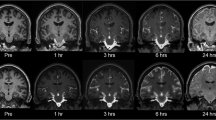Summary
Fifty patients underwent myelography with the newly developed CSF-isotonic, dimeric, non-ionic contrast medium Iotrolan. Repeat spinal and cranial computerised tomographic studies with measurement of the attenuation values were conducted to demonstrate the administered contrast medium in the spinal canal and intracranial subarachnoid space. The patients were examined neurologically, observed clinically and asked about concomitant symptoms. The period of retention and the spread of the contrast medium in the subarachnoid space was not found to have any influence on the side effects rate. In particular, no association was confirmed between intracranially demonstrable contrast medium and the occurrence of side effects.
Similar content being viewed by others
References
Avrahami E, Cohn DF (1982) Zum Problem der postmyelographischen Kopfschmerzen. Schweiz Arch Neurol Neurochir Psychiatr 130:157–160
Baker FJ, Gossen G, Bertoni JM (1982) Aseptic meningitis complicating Metrizamide myelography. AJNR 3:662–663
Batty VB (1984) Cervical myelography using Iohexol (Omnipaque) a new contrast medium. Clin Radiol 35:75–77
Bergvall V, Brismar T, Lying-Tunell U, Valdimarssion E (1981) Confusion, myeloclonus and speech arrest: Epileptic manifestations after metrizamide myelography. Acta Neurol Scand 63:315–322
Bradac GB, Kaernbach A (1981) Selektive zervikale Myelographie mit Metrizamid (Amipaque). Radiologie 21:199–202
Büchele W, Kunitsch G, Brandt Th (1979) Die lumbale Myelographie mit Methylglucamin-Jocarmat (Dimer X). Röntgen-Bl 32:39–45
Caillé JM, Gioux M, Arné P, Paty J (1983) Neurotoxity of nonionic iodinated watersoluble contrast media in Myelography: experimental study. AJNR 4:1185–1189
Dixon WJ (1981) BMDP Statistical software Biomedical computer programs
Drayer BP, Vasallo C, Sudilovsky S, Luther J, Wilkins R, Allen S, Bates M (1983) A double-blind clinical trial of iopamidol versus metrizamide for lumbosacral myelography. J Neurosurg 58:531–537
Eldevic OP (1982) Side effects and complications of myelography with water soluble contrast agents. J Oslo City Hosp 32:21–138
Galle G, Huh W, Arnold K (1984) Psychopathometric demonstration and quantification of mental disturbances following myelography with metrizamide and iopamidol. Neuroradiology 26:229–233
Gelmers HJ (1981) Acute psycho-organic reactions after cervical myelography using metrizamide. Clin Neurol Neurosurg 82:57–61
Greitz T, Hindmarsh T (1974) Computer assisted tomography of intracranial CSF circulation using a water-soluble contrast medium. Acta Radiol 15:497–507
Gulati AN, Guadagnoli DA, Quigley MD (1981) Relationship of side effects to patient position during and after metrizamide lumbar myelography. Radiology 14:113–116
Hammer B (1981) Neuroradiologische Erfahrungen mit Iopamidol, einem neuen nicht-ionischen wasserlöslichen Kontrastmittel. Radiologe 21:274–281
Hammer B (1981) Die Computertomographie-Zisternographie-Technik und Pathophysiologie als Ursache der Nebenerscheinungen. Röntgen-Blätter 34:185–189
Hauge O, Falkenberg H (1982) Neuropsychologic reactions and other side effects after metrizamide myelography. AJNR 139:357–360
Hekster RE (1982) Adverse effects of metrizamide. Clin Neurol Neurosurg 84:132–133
Kausch W (1981) Die ambulant durchgeführte Myelographie. Röntgen-B1 34:91–93
Kieffer SA, Binet EF, Davis DO, Gabrielsen TO, Kido DK, Latchaw RE, Turski PA, Schaw DD (1984) Lumbar myelography with iohexol and metrizamide: a comparative multicenter prospective study. Radiology 5:665–670
Killebrew K, Whaley RA, Hayward JN, Scatliff JH (1983) Complications of metrizamide myelography. Arch Neurol 40: 78–80
Krüger J, Von Wild K, Hacker H (1977) Wie gefahrlos ist die lumbosacrale Myelographie mit wasserlöslichen Kontrastmitteln? Dtsch Med Wochenschr 102:342–345
MacPherson P, Teasdale E, McGeorge AP (1983) Direct puncture versus run up cervical myelography with iopamidol: a comparison of side effects, EEG changes and radiographic quality. J Neurol Neurosurg Psychiat 46:959–962
Petterson H, Fitz CR, Harwood-Nash CF, Armstrong E, Chuang SH (1982) Adverse reactions to myelography with metrizamide in infants, children and adolescents. Acta Radiol Diagn 23:323–329
Pritchard PB, O'Neal DB (1984) Nonconvulsive status epilepticus following metrizamide myelography. Ann Neurol 16:252–254
Robertson WD, Lapointe JS, Nugent RA, Robinson RG, Daly LF (1980) Positioning of patients after metrizamide lumbar myelography. AJNR 134:947–948
Sartor K (1979) Aszendierende und deszendierende Myelographie mit wasserlöslichem Kontrastmittel. Röntgen-B1 32: 251–256
Schmidt RC (1979) Myelographie mit Metrizamid: Technik-Pharmakokinetik-Nebenwirkungen-Untersuchungsergebnisse. Habil-Schr, Hannover, Med Hochschule
Stoeter P, Bergleiter R, Schneider I, Kubina FG (1982) Nebenwirkungen und Kontrastmittelresorption von Jopamidol und Jocarmat bei der lumbalen Myelographie. CT-Sonographie 2:179–183
Vogelsang H, Schmidt RC (1979) Spinale Reizerscheinungen nach Myelographien mit Amipaque bei Patienten mit schweren Kyphoskoliosen. Fortschr. Röntgenstr 131:90–92
Author information
Authors and Affiliations
Rights and permissions
About this article
Cite this article
Hoffmann, B., Becker, H. & Wenzel-Hora, B.I. Influence of the spread and period of retention of Iotrolan in the subarachnoid space on the side effects rate in myelography. Neuroradiology 29, 380–384 (1987). https://doi.org/10.1007/BF00348919
Received:
Issue Date:
DOI: https://doi.org/10.1007/BF00348919




